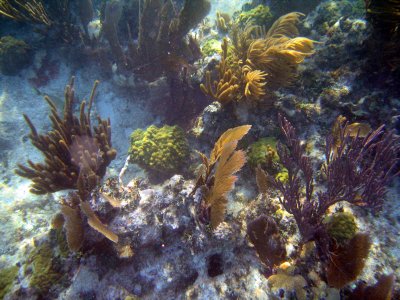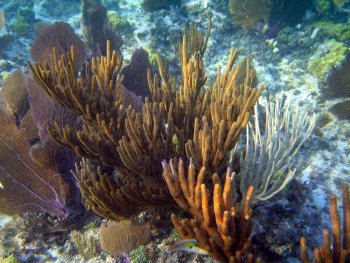The Coral Reef
Coral reefs are fragile, living ecosystems increasingly being threatened and damaged by pollution, disease and habitat destruction. EPA has several activities involving the protection of coral reefs. Further education of the coral reef biological indicators is important to bring additional awareness to these very unique ecosystems.
Coral reefs are among the world's richest ecosystems, second only to tropical rain forests in plant and animal diversity. However, they are extremely sensitive environments that have special temperature, salinity, light, oxygen, and nutrient requirements. If environmental conditions fall outside the acceptable range of these requirements, the health and dynamics of a coral reef community can be severely disrupted. That's why coral communities are sensitive indicators of water quality and the ecological health of the coastal watershed.

Corals themselves are tiny animals which belong to the group cnidaria (the "c" is silent). Other cnidarians include hydras, jellyfish, and sea anemones. Corals are sessile animals, meaning they are not mobile but stay fixed in one place. They feed by reaching out with tentacles to catch prey such as small fish and planktonic animals. Coral reefs provide habitats for a large variety of organisms. These organisms rely on corals as a source of food and shelter. Besides the corals themselves and their symbiotic algae, other creatures that call coral reefs home include various sponges; molluscs such as sea slugs, nudibranchs, oysters, and clams; crustaceans like crabs and shrimp; many kinds of sea worms; echinoderms like star fish and sea urchins; other cnidarians such as jellyfish and sea anemones; various types of fungi; sea turtles; and many species of fish.
The Hawaii Coral Reef Initiative
Reserach Program ![]() has a detailed discussion of monitoring and assessment efforts for corals,
reef fish, and algae and provide insights into indicators that are (or could
be) used for managament decisions. EPA's Office of Water has outstanding Web
resources that are highly recommended (the language above came from those
resources). Please start there to learn more about coral reefs and their protection.
Let's learn more about corals and coral reefs:
has a detailed discussion of monitoring and assessment efforts for corals,
reef fish, and algae and provide insights into indicators that are (or could
be) used for managament decisions. EPA's Office of Water has outstanding Web
resources that are highly recommended (the language above came from those
resources). Please start there to learn more about coral reefs and their protection.
Let's learn more about corals and coral reefs:
- more about biological indicators of coral reef health
- what stress and diseases are affecting corals?
- find out what types of fish live
in coral reefs
- view the Reef Relief presentation on the State
of the Reef 2004

More Important Links:
Environmental Protection Agency
- Development of Coral Reef Biocriteria
- Office of Water Coral Reef Protection and Coral Reefs and Your Coastal Watershed
- Office of Water About Coral Reefs
- Region 4 South Florida Geographic Initiative
- Region 9 Coral Reefs
- US Coral Reef Task Force
- Coral Reef Web Links
National Oceanic and Atmospheric Administration (NOAA)
- Coral Reefs
- Coral Health and Monitoring Program
- Florida Keys National Marine Sanctuary
- The State of Coral Reef Ecosystems of the United States and Pacific Freely Associated States: 2005
U.S. Department of the Interior
U.S. Geological Survey
- Science for the Conservation of Coral Reefs
- Protecting the Nation's Coral Reefs
- Coastal and Marine Geology Program

The inclusion of a link below does not constitute an endorsement by EPA of any organization's policies or activities, or of any item for sale. EPA makes no guarentees regarding information, data or links contained on non-EPA web sites.
- Southeast Florida Coral Reef Initiative
- Hawai`i's The Living Reef by The Nature Conservancy
- Reef Relief
- University of Hawai`i Hawaii Coral Reef Initiative
- Center for Biological Diversity Caribbean Coral
- University of Miaima National Center for Coral Reef Research
![[logo] US EPA](https://webarchive.library.unt.edu/eot2008/20081111080725im_/http://www.epa.gov/epafiles/images/logo_epaseal.gif)